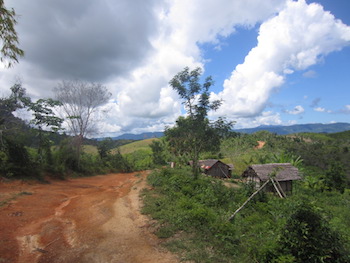Mel is an intern with Earthworks. She studied abroad in Madagascar while attending Oberlin College.
In April 2015 staring out the window of the “taxi brousse” I watched the rolling hills of rice fields and forests pass by, barely visible in the moonlight. I looked up and found the Southern Cross constellation in the sky. I was traveling towards the Ampasindava peninsula in the northwestern part of Madagascar with a Malagasy colleague (and friend) to conduct research on a mining project. In that moment, sitting on a bus in the middle of the night that I realized for the thousandth time that there are so many things I don’t know.
I chose to go to Ampasindava because there are two international entities with overlapping land claims given to them by the Malagasy government. By having claims to the same piece of land, these organizations both affect the same communities. One organization, Missouri Botanical Garden (MBG), is an American NGO concerned with environmental conservation. The other is a mining company, named Tantalus (or its subsidiary Tantalus Rare Earths Madagascar – TREM), searching for certain elements and metals vital to the production of electronics and called “rare earths elements”. Before talking to the villagers I assumed that they would prefer TREM to MBG. If they both have already taken the villagers land, I figured, at least TREM would claim that they would create well paying jobs.
I was completely wrong. There were some people who liked MBG, and some who did not. Yet, there was only one person who responded optimistically to the question “Do you believe that TREM will continue towards an extraction phase? And if so, will that be beneficial for you?” The others were full of worries and several villagers asked us to share these worries so that others would know about their situation.
Speaking generally, the 62 people whom we interviewed had a lot in common. Everyone relies on the land for their livelihood and survival, and every member of the community is a farmer. The land on the peninsula is incredibly fertile and accordingly many of Madagascar’s most well known cash crops are grown in Ampasindava: vanilla, pepper, coffee, cacao and rice. We were there during the rice harvest season, when most of the villagers are living in a smaller, second home out in their rice fields to have more time for the harvest. For nearly everyone, the village where they live is the one they were born in; it’s their ancestral land – their tanindrazana – which is of great cultural significance. The villagers told us that they’re afraid that TREM will completely destroy their land, the agricultural fields, village, and sacred land.
The first cause for concern when we were there a year ago was the holes TREM dug to acquire samples of the mud to test for the quantity of rare earths elements found there. Each hole is a one square meter opening dug ten meters deep. The holes are everywhere, dotting everyone’s fields, punctuating the forests, perforating protected land, and even tearing up sacred lands. A lot of people don’t even know who dug the holes on their own fields. They told us that the holes just appeared, without permission, without warning, and without compensation. The majority of the villagers talked about their powerlessness in the face of TREM and the state. One time when TREM representatives came through to dig holes, a farmer told us, he tried to refuse. The response he got from the representatives was, “ You can dig them yourself and we’ll pay you, or we’ll just find someone else to do it.”

Heading south on the main road
In addition to telling us of the injustice perpetuated by fear and power, the villagers also told us of several tangible effects of the holes. First of all, holes have been dug on villager’s sacred lands. It is expressly forbidden by the Madagascar mining code (chapter 3, article 105) to extract or conduct research for that extraction in an area within 80 meters of a sacred site. Also, the holes are not always refilled, and even when they are, rain causes the newly filled in earth to drop, leaving only partially filled holes.
These partly filled holes pose a problem for the cattle, as several people told us that their cattle fell into the holes and died. The villagers would also like to receive compensation for these losses. Moreover, even when the holes are completely filled in, farmers find that nothing can grow in the refilled dirt. They worry that when full extraction starts, even if the holes are all filled in, the land will no longer be fertile.
In the end, every interview turned into a discussion of fears and hopes for the community. Community members are scared of a total loss of their land, and accordingly their way of life. They are scared of water contamination in their rivers, and a few people explicitly told us they are scared that if full mining begins, their agricultural fields will be destroyed, leaving them with no food, and they will die. Unfortunately, these are not baseless worries, as made evident by the examples of rural villages completely destroyed by rare earths mining in Asia.
So what do the villagers want? Really, they want TREM to leave, but they know that it’s too late for that. So they want financial compensation for extraction on their lands, even for people who do not have documents of ownership. Moreover, they want compensation for their community: they want a school and a hospital, or at least a more passible road so they can access the businesses and services of nearby communities more easily.
But more than anything, they want a say in their own futures, they want the power to fight for their rights.


